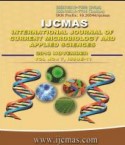


 National Academy of Agricultural Sciences (NAAS)
National Academy of Agricultural Sciences (NAAS)

|
PRINT ISSN : 2319-7692
Online ISSN : 2319-7706 Issues : 12 per year Publisher : Excellent Publishers Email : editorijcmas@gmail.com / submit@ijcmas.com Editor-in-chief: Dr.M.Prakash Index Copernicus ICV 2018: 95.39 NAAS RATING 2020: 5.38 |
Electronic devices are increasingly used by the healthcare workers. They can get contaminated with pathogenic organisms and can act as a source of healthcare associated infections. In this study we aimed to determine the bacterial contamination rates of the electronic devices handled by the healthcare workers posted in high risk areas like ICU’s, NICU’s and operation theatres. Swabs were collected from personal electronic devices of 40 healthcare workers and from 33 common devices used in high risk areas. The participants were divided into 4 groups: doctors, residents, nurses and theatre technicians. The swabs were streaked onto blood agar and MacConkey agar and incubated at 37degree Celsius. The isolates were identified and were subjected to antibiotic susceptibility tests by standard procedures. Of the 45 personal devices including mobile phones and laptops swabbed, 86.7% showed growth of organisms. Coagulase negative staphylococcus species was the most common organism, isolated at the rate of 50.9%. Of the gram- negative bacilli isolated, 16.6% showed ESBL production. The rate of MRSA isolation was 3%. It was found that among the participants 63% and 62.5% were found to be not disinfecting their devices and hands respectively. Electronic devices were found to be carriers of infectious pathogens. Strict guidelines have to be introduced for proper usage and disinfection of the devices and hands.
 |
 |
 |
 |
 |